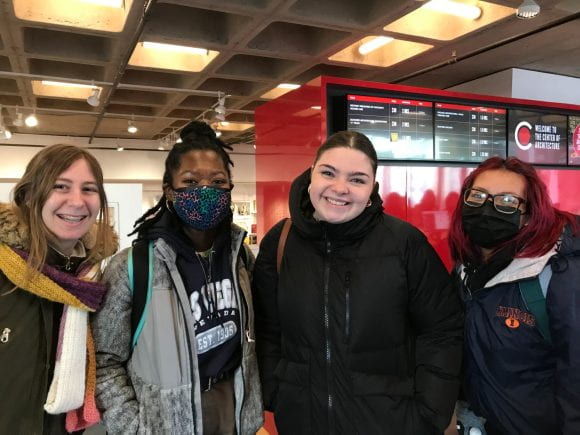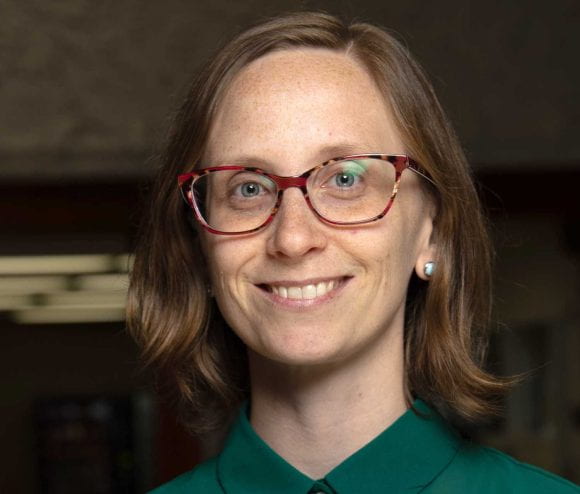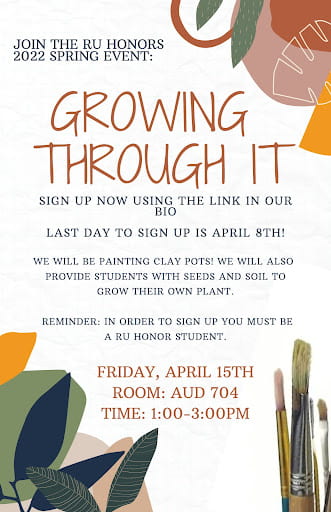By: Onteya Zachary
On Friday, February 24th, Honors Exchange participants reunited for the second time since the start of the Spring semester at the Chicago Architecture Center. After our first time reconvening on Friday January 27th for a tour of the Auditorium building and theater led by university historian Dr. Lynn Weiner, we hadn’t had much time as a class to discuss what we experienced in our walkabouts over Winter break. The walkabout project was an asynchronous activity over the months of November and December (and into January) where we were enabled to continue our conversation about the design of neighborhoods by focusing on neighborhoods we’d be touring later in the semester known as Chicago’s “first five” (Bronzeville, Chinatown, Greektown/West Loop, Little Italy, and Pilsen).
Students were randomly assigned to a neighborhood and each group roughly consisted of three members. Madeline LaFrambois (freshman), Emily Sanchez (junior), and Denise Merodio Gomez (sophomore) were assigned to the Bronzeville community. As a group, they ventured for well over two hours exploring the area and taking note of not only building design, but how narrative and community identity were communicated through statues of notorious musical figures relevant to the history of Bronzeville such as performers who visited the area. From Etta Moton to Nat King Cole, African American musicians and music such as jazz, blues, or gospel music were greatly informed by the migration of Southern black musicians. Most notable from their presentation was their coverage of the Defender building. Located on King Drive, the Chicago Defender was one of the most successful African-American newspapers of great influence during the Great Migration.
The Chicago Defender was founded in 1905 by Robert S. Abbot. Even though it was only a kitchen table publication, it grew to be the most powerful African-American newspaper in America. What is so important about this newspaper is that Abbot wrote about the rights of African-Americans, to protest on discrimination, being able to have a voice about political and personal action, hopes of the blacks. Bronzeville was a black metropolis and one of the nation’s most significant landmarks in African American urban history. The Bronzeville group benefited from experiencing one of Chicago’s first neighborhoods as it stands today. More importantly, they collaborated in a project where they got to better understand how planned (and unplanned) environments shape experience, identity, access, assets, and resources, barriers and boundaries, possibility, impossibility, and more. The findings, synthesis, and reflection they presented the other exchange participants with while presenting their project on Bronzeville was stimulating.
Each group presented for roughly an hour of the exchange before we put on our coats and headed outside for an on-foot adventure. We began outside of the Chicago Architecture Center observing the land on which the Apple store (401 Michigan Ave.) sat on. Angela Esposito, the Director of Education and Experience at Chicago Architecture Center, contextualized this land as the space in which Jean Baptiste Pointe DuSable’s first trading post sat. Moreover, Angela unsilenced DuSable’s wife, Kittihawa, in the legacy of his success by informing us that she played a crucial role in his success with developing a prosperous trading post on native land considering she aided in translation between the tribes and DuSable. Following that, we moseyed along as a group to a building wrapping its great size around the corner of Michigan Avenue and Wacker Drive and overlooking the cities; the building was none other than the historic London House.
Here, we examined some of the notable features present in the architecture of the building which was produced during a booming period of industrialization in the 1920s with the arrival of the World’s Columbian Exposition of 1893. Designed by Alfred S. Alschuler, the London House is representative of Beaux-Arts aesthetics with its classical inclusion of Corinthian columns and engravings of Roman figures in the stone facade. Exchange participants gazed at the architecture and ornate design in awe. Next, we walked to the end of the block and stopped in front of the Christian Science Reading Room and our attention was directed to two beautifully outstanding “corn-cobs” or Marina City. Marina City, although we could not venture inside, was a fantastic sight for us all even at such a distance away from the actual building. Angela informed us that the building was designed with the intention of creating affordable housing and the idea of concentrating all the essentials one would need to live (i.e. a grocery store, a car, a gym- to name a few) for those that would live in the city. It was for a time, the tallest residential building in the world and the tallest building made out of reinforced concrete.
One of our last stops on the walking tour was to and inside of the Carbide and Carbon building. It was built by the sons of prominent Chicago architect Daniel Burnham’s, Hubert Burnham and Daniel Burnham Jr.. The exterior of the building is covered in polished black granite, and the tower is dark green terra cotta with gold leaf accents. The use of stylized representations of leaves on the building’s exterior was an intentional reference by the architects to the prehistoric origins of subterranean carbon deposits in the decay of ancient plants. When we walked in, the lobby featured a black Belgian Marble and Art Deco bronze work trim. In addition, many of the designs were informed– as we learned from Angela– by the discovery of King Tut’s tomb in Egypt. Thus, several references to Egyptian pictorials found in the tomb of King Tut such as lotuses were present in the architectural design.
Angela also informed us of a popular myth that the Burnham Brothers supposedly designed the building to resemble a dark green champagne bottle with gold foil at the top. After spending a few more moments admiring the building and reflecting on our time together we all departed. For a more visual understanding of our journey and on-foot adventure, feel free to poke around this Google Map: https://www.google.com/maps/d/edit?mid=1Ew4jdhRMih7i4te5sFQYW-1D8FaIwnA&usp=sharing
We look forward to our time together on March 31st, 2023 where we will board a double decker bus and tour the “first five” neighborhoods of Chicago as a collective!






















